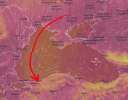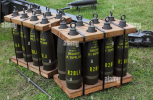The 5 August substation blast prompted one of Zaporizhzhia’s three operating units to automatically shut down. It also left the plant with just one grid connection, compared with 7 preinvasion connections. That jeopardizes the entire plant, which uses grid power to cool all six of its reactors and spent fuel pools.
Energoatom CEO Petro Kotin said it put Zaporizhzhia “very close” to the situation that produced the 2011 Fukushima meltdowns.
Batteries and diesel backup generators are designed to power the plant’s cooling systems for 10 days. But Haverkamp says “an emergency situation or even meltdown” is possible well before then.
Alleged corruption before Russia’s invasion raises doubts about the reliability of Zaporizhzhia’s backup systems. Haverkamp also cites the plant’s “exhausted and decimated” Ukrainian staff, and the possibility of a power struggle with their Russian occupiers over how to manage an emergency.
Ukraine’s state nuclear-safety center projects that Zaporizhzhia’s operating units could experience reactor damage in as little as 3 hours without power, according to a May 2022 assessment
revealed last week by Kyiv-based MIND. Horrific consequences could follow. The agency that manages the Chernobyl Exclusion Zone projected last week that
shells or rockets hitting Zaporizhzhia might unleash an accident 10 times worse than Chernobyl’s. The agency stated that radioactive emissions could kill tens of thousands of people, displace 2 million, pollute an area three times the size of Ukraine, and create a long-term exclusion zone as large as 30,000 square kilometers.












